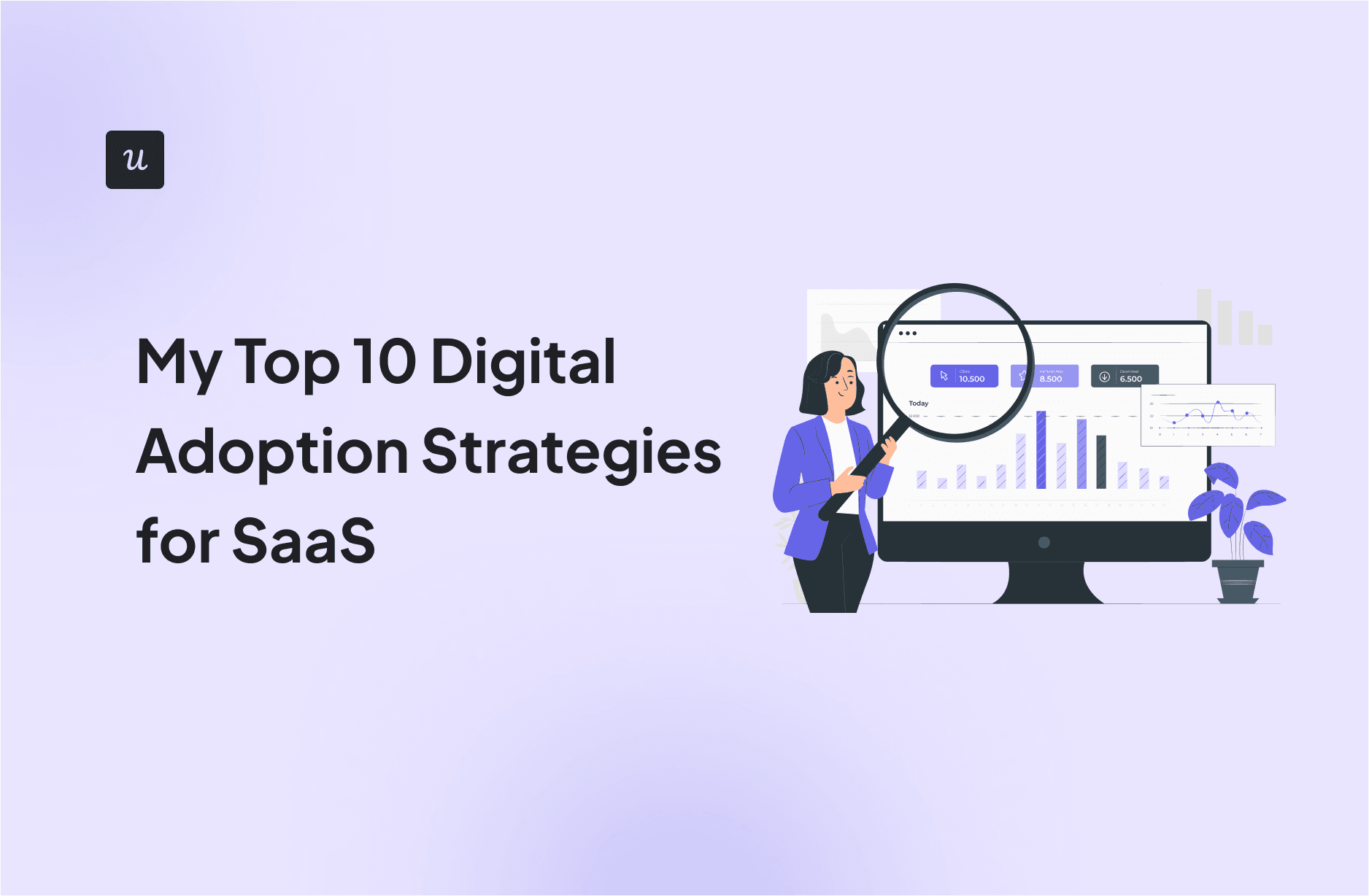
I’ve deleted so many new software I wanted to use because I couldn’t figure them out.
8 in 10 users do the same thing. That behavior doesn’t change in SaaS. Users sign up, hit friction, and abandon before seeing value. Every confused user represents revenue you’ll never recover.
But a few effective digital adoption strategies can flip this completely. They turn “I don’t get this” into “I can’t work without this.”
At Userpilot, I’ve studied patterns across 500+ SaaS products. The teams hitting 60% activation obsess over time spent getting to value. They guide users to the first aha moment in under 3 minutes, drive action in the first session, and make product adoption feel frictionless.
I’m sharing 10 strategies that drive digital adoption rates.
Try Userpilot Now
See Why 1,000+ Teams Choose Userpilot

What is digital adoption?
Digital adoption is the process of integrating digital technologies to ensure employees’ and customers’ effective usage of technologies to achieve desired business outcomes.
In SaaS, digital adoption refers to ensuring users can learn your tools effectively and apply them to solve their jobs-to-be-done (JTBDs).
Digital adoption vs digital transformation
The main difference between digital adoption and digital transformation is that the former is user-centric while the latter is organization-centric.
Digital adoption is a part of a company’s digital transformation efforts. It focuses on improving user experience using digital technology. And digital transformation is about overhauling digital processes and operations fundamentally across the entire organization.
Why does digital adoption matter?
Strong digital adoption is important for SaaS businesses because it directly impacts your bottom line.
- Enhance user and product engagement by offering intuitive and user-friendly features and making the experience smoother.
- Improve user experience and satisfaction while you take on digital adoption strategies that streamline processes and provide personalized, contextual guidance.
- Drive user retention by ensuring users consistently use and find value in the product.
What are the common digital adoption challenges?
I’ve worked with hundreds of teams, and the pattern is clear. 74% of companies struggle to scale digital technologies and improve technology usage, citing people, not tech, as the main barrier. The most common digital adoption challenges are:
- Change resistance: Users stick to old habits due to fear, low confidence, or lack of motivation.
- Weak onboarding: Traditional training and no in-app guidance create immediate user frustration.
- Missing value and leadership: Users don’t see personal benefit, and enterprise leaders fail to reinforce adoption.
These challenges cost real money and directly impact operational efficiency. Employees lose 25 working days per year struggling with enterprise software; time that should be spent on core business processes. Moreover, 90% of executives have seen significant investments fail due to poor digital adoption. Without addressing them, successful digital transformation remains out of reach.
10 Key digital adoption strategies to improve user engagement
Let’s look at the key digital adoption strategies that improve user engagement and enhance customer experience.
I will also talk about some digital adoption tools that make the work easy.
Segment users from the start to personalize user experience
Firstly, you need to collect information about your users via welcome surveys. Keep the questions to a minimum, such as their role, JTBDs, and how they plan to use your software application.
You should use this information to segment your users according to users’ common attributes. It lets you create a contextual onboarding process tailored to customers’ needs. Offering users personalized experiences from the start improves customer retention and builds long-term engagement.
Here’s how Miro uses the welcome survey as a part of its digital adoption strategies.
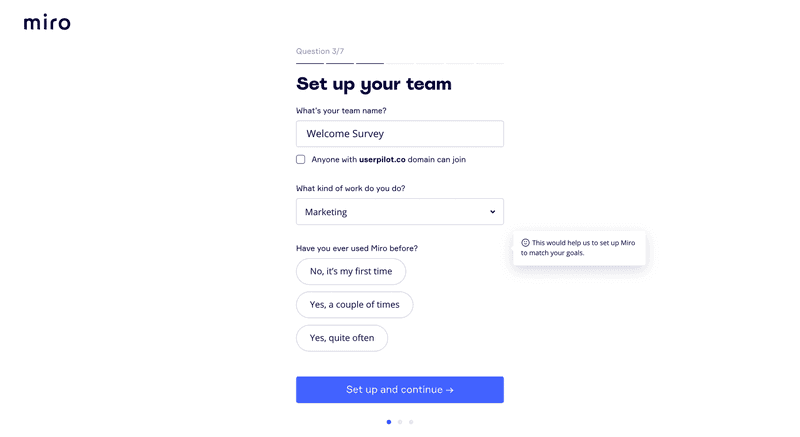
With Userpilot, I can easily build such a welcome survey and use collected survey responses to trigger different onboarding flows.
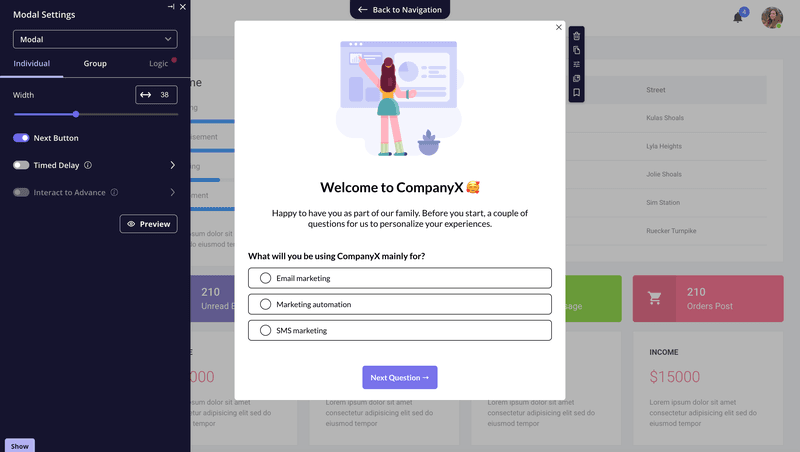
For example, when a user selects “Email Marketing” they see a checklist focused on building the first email campaign. When someone selects “Marketing Automation”, they will land on a canvas with a checklist to create their first automation flow.
Encourage users to try relevant features with onboarding checklists
Prompting users to try relevant features for their JTBDs help them realize value early in the digital adoption process. It also helps you increase user adoption and satisfaction with your product.
One effective way to encourage users is by providing them with onboarding checklists. You need to identify the most important actions for users to take and place them in order on the checklist.
When you break down the onboarding checklist into small tasks, users are more likely to complete it and learn to use your product more easily.
You can build personalized onboarding checklists based on their interests/goals in Userpilot. Set completion triggers (like “created first dashboard”), show progress indicators, and automatically unlock the next step when users finish a task. This keeps users moving forward instead of getting stuck.
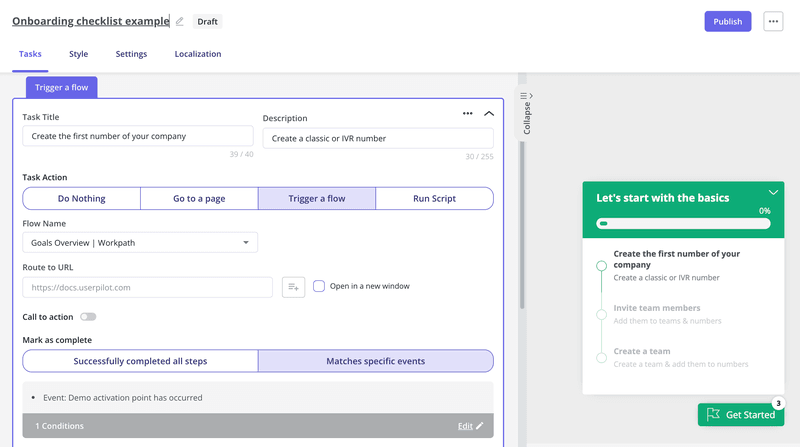
Let me show you how this played out for Digibee. They added targeted onboarding checklists and saw customers complete key actions 2.6x faster and create twice as many pipelines. This sustainable growth was driven by Userpilot’s targeted onboarding checklists.
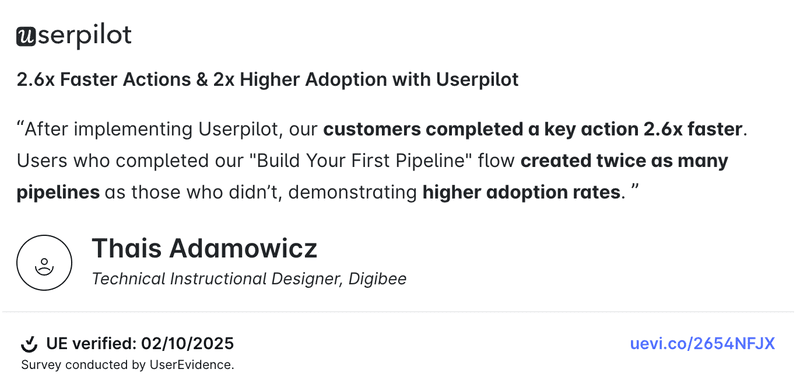
Provide in-app guidance with interactive walkthroughs
One of the big challenges users face when adopting a new software solution is figuring out how to use it effectively. But providing in-app guidance with interactive walkthroughs will help reduce users’ time and effort to grasp digital tools’ features.
Interactive walkthroughs provide users with step-by-step guidance on using specific features within your product. They make the experience engaging and encourage users to explore and experiment as they learn at their own pace, leading to genuine digital adoption.
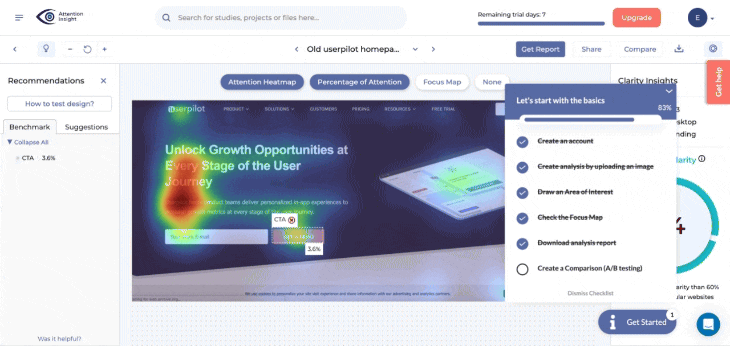
Attention Insight – one of our customers has successfully put this into practice. They used Userpilot’s interactive walkthroughs to guide trial users through creating heatmap analyses, their core activation feature. This resulted in faster time-to-activation and higher trial-to-paid conversion rates.
“Increasing the number of users who create heatmap analyses during their free trial is crucial to conversions. Interactive walkthroughs helped us guide users to that ‘Aha’ moment faster.”
— Attention Insight team
Trigger tooltips to provide contextual and personalized training
Triggering tooltips is an effective way to provide just-in-time learning when users need it the most. Users understand how to use a feature in context with the tooltips and become more likely to adopt it.
Tooltips, like onboarding tooltips, in-place tooltips, etc., are handy for guiding the user through the feature’s usage with step-by-step instructions. It fosters digital adoption while ensuring users use your product to its full potential.
Figma uses tooltips contextually like this:
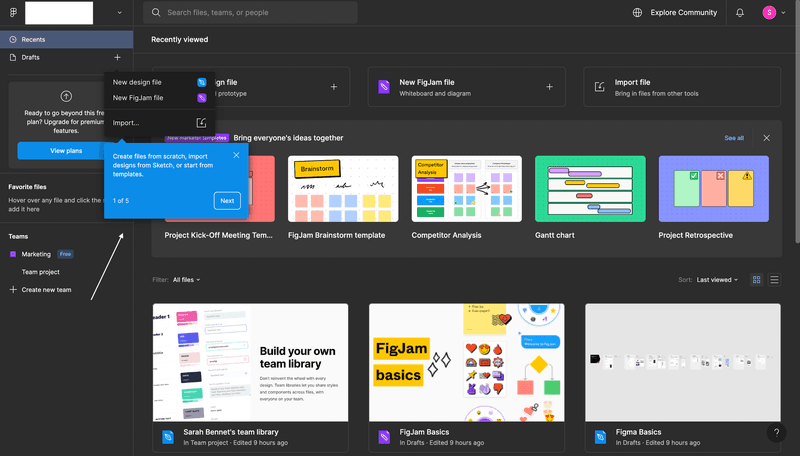
You can easily create the same kind of tooltips in Userpilot that trigger based on specific user actions or page visits.
For example, show a tooltip when a user hovers over “Invoice” for the first time, or when they land on your analytics dashboard without ever running a report. You can set triggers based on events and a wide range of other user properties.
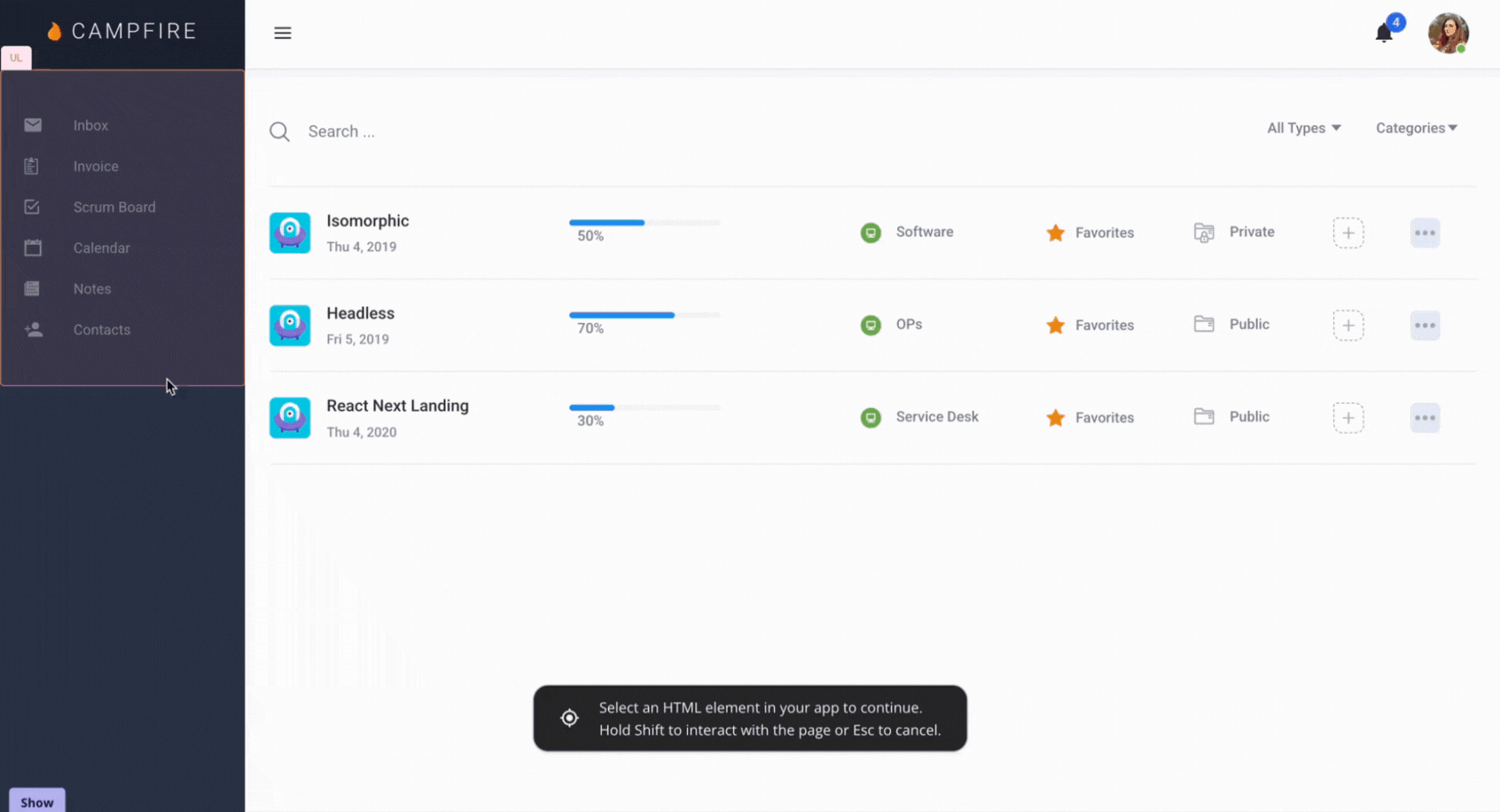
Creating tooltips in Userpilot is already no-code, but we’re making it even faster.
Instead of setting up triggers manually, you’ll soon be able to tell Lia (our AI agent) what you want, like “help users understand this metric,” and it will build and deploy the tooltip for you.
Want early access? Join the waitlist to try it first.

Celebrate user achievement with gamification
The idea around gamification is to use game mechanics to motivate users to complete tasks and achieve specific goals. It helps you encourage users to finish core tasks and explore different features of the product.
Gamification boosts customer engagement as users enjoy recognition for completing complex tasks or achieving specific milestones. Doing so creates a fun, interactive environment that makes customers use your product regularly.
Here’s how Asana celebrates user achievement with a flying unicorn.

We actually had a customer who adopted this exact approach.
Groupize built a gamified assistant called “G.G.” that walks users through onboarding with progress bars and little celebrations along the way. Now users solve basic setup questions on their own, so support tickets are way more focused.
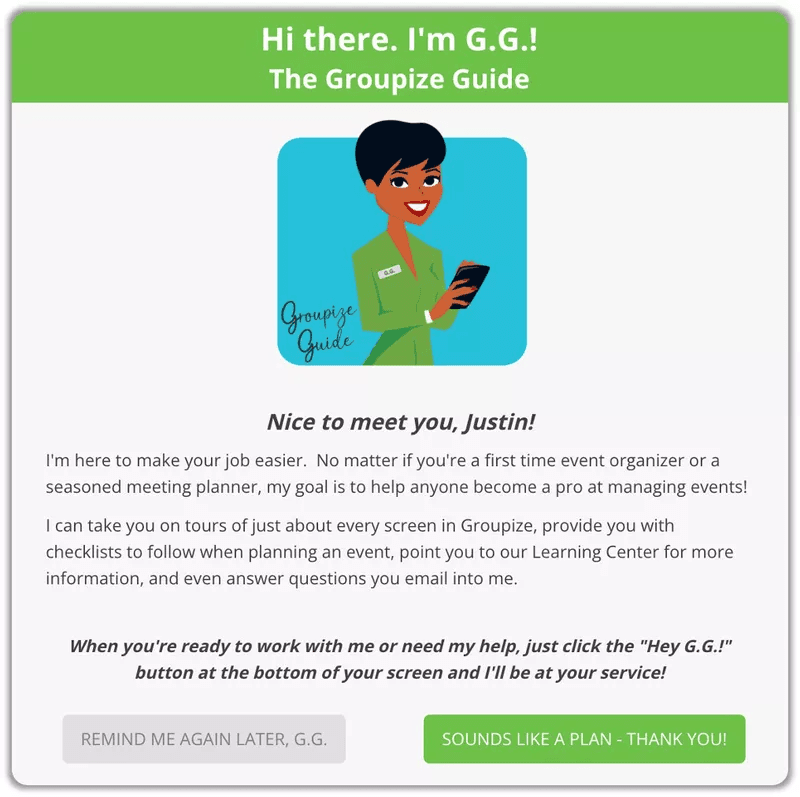
Provide self-serve guides in different formats
Providing self-serve guides in multiple formats has the potential to be a game-changer in your digital adoption strategies. As users have different learning preferences, support resources in various formats allow them to learn about your product in a way that suits them best.
Self-serve materials, like help centers, video tutorials, etc., increase product knowledge among your customers. It drives digital adoption as users utilize your product to its fullest potential.
I may be biased, but our resource center functionality has been a powerful tool for us to provide such self-serve resources inside our product.
When building one with Userpilot, you can include the following materials in your resource center:
- Onboarding checklists that guide users through key setup tasks.
- Video tutorials embedded on relevant feature pages so users can watch demos right where they need them (users who watch a 90-second onboarding video are 2× more likely to convert to paid plans).
- Help articles with searchable, detailed instructions.
- Feedback widgets to collect user input without leaving the app .
What makes this especially powerful is the ability to show specific modules to specific users based on user properties, behavior, or custom conditions. For example, you can display advanced feature tutorials only to power users, or show beginner guides exclusively to new users.
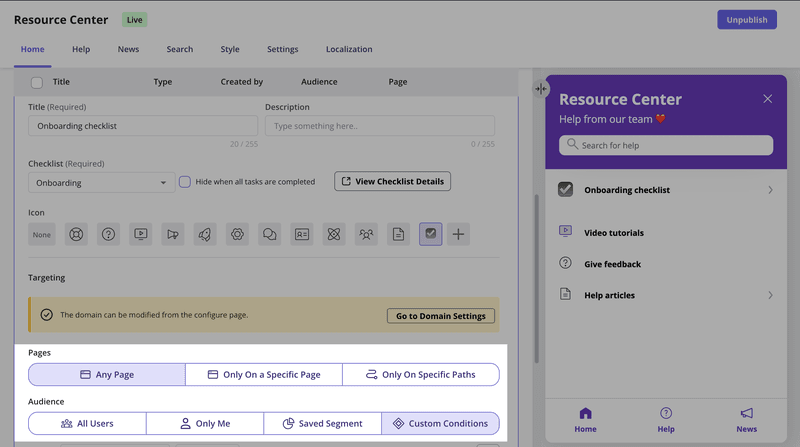
You’ll also get the analytics insights that you can use to improve your self-serve guides from time to time. Think of knowing what terms users search for inside your resource center, or which one is your most or least popular help module.
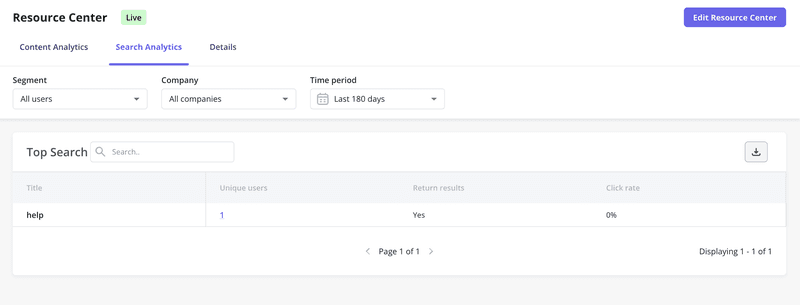
Use in-app messages to introduce new features contextually
In-app messaging provides in-app support that helps users discover and adopt new features without leaving your product.
This is a tactic you shouldn’t miss out on, given how widely adopted this is across SaaS products. Look at how Google Docs used slideout to introduce new features.
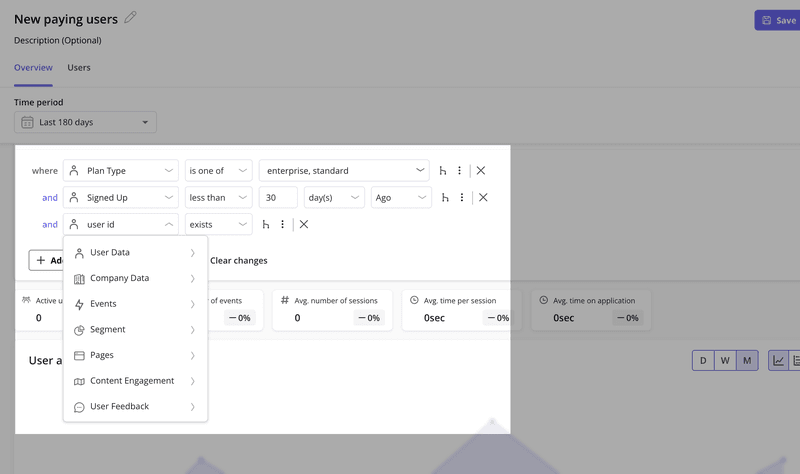
You should have a well-planned in-app messaging strategy to make the most of in-app messaging. It requires you to target relevant user segments who find your new features useful.
Then, you must decide on the perfect notification types and send in-app messages that prompt engagement.
I’ve seen announcement engagement jump 3x when you segment properly.
In Userpilot, you can target by plan type (paid vs. free), user behavior (pages visited, features used), company data (team size, industry), and custom properties like role or department. Show analytics features to paid users who haven’t visited reports or show collaboration tools to active teams with 5+ members.

As the relevant user segments will find more value in your new features, they will adopt them more and engage with your product.
Provide users with proper training by hosting webinars
Webinars offer a more interactive and engaging way of learning compared to just reading through guides or watching tutorial videos. It focuses on preventing feature blindness and helping users unlock more product value, making your digital adoption solutions successful.
You should segment users based on their behavior and needs to ensure the ongoing training is valuable.
It helps you send the right invitations to the right users, tailor the content to them, and offer the most value. You also need to use the segments to send invitations through multiple channels like in-app and email.

Track digital adoption progress to spot early friction
You should measure digital adoption progress by tracking feature and product usage, process completion rates, onboarding checklists, and in-app behavior. It allows you to accurately spot where users encounter friction or where important features are underutilized.
For example, by analyzing user behaviors, you can see if users tend to drop off at a certain point in the funnel. This could be an indication that there is a problem with the user experience or messaging.
I always encourage my team to use path and funnel analysis to pinpoint friction. Path analysis shows the actual routes users take, revealing unexpected behaviors.

Meanwhile, funnel analysis tracks conversion through specific workflows and identifies exactly where users drop off.
For example, if path analysis shows users consistently drop off after viewing a feature demo but before trying it themselves, add an interactive walkthrough or simplify the first-use experience.
Making these moves while tracking the digital adoption process will double your digital adoption efforts and improve your conversion rate.

Soon, you will be able to use Userpilot’s AI Insights to spot these patterns without manual processing. The AI agent can help you surface anomalies (like sudden drop-offs or usage spikes), identify correlations (which user behaviors predict success), and send proactive alerts about what needs attention.
Collect feedback and close the feedback loop
Regularly collecting user feedback through in-app surveys is essential to digital adoption strategies. You need to craft these surveys strategically by using various survey questions, including closed and open-ended questions. The qualitative and quantitative feedback from these surveys will help you identify what is preventing you from delivering a seamless user experience.
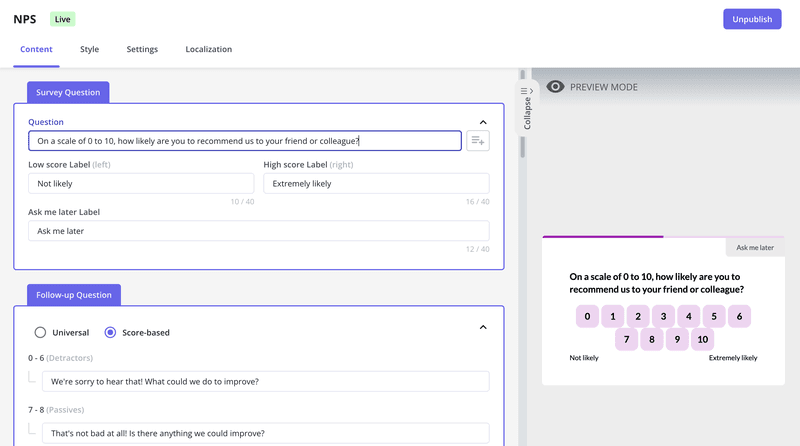
Analyzing this feedback data is essential in closing the feedback loop and making informed decisions about product improvements.
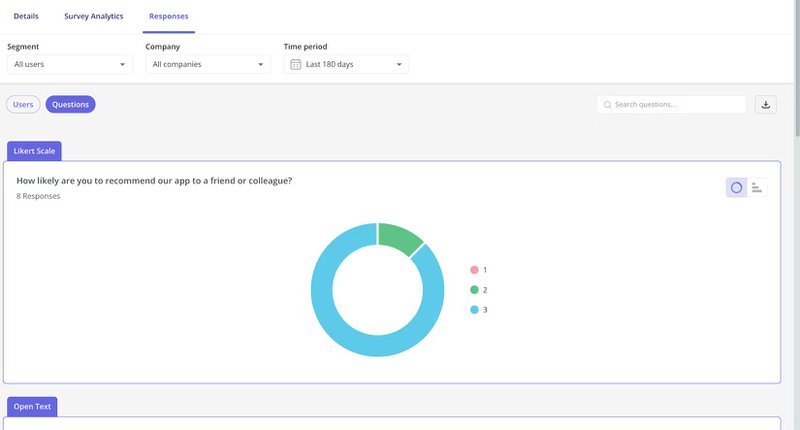
These improvements could include introducing new features, upgrading existing ones, or addressing pain points based on the type of survey you trigger (i.e., customer experience, feature requests, etc.).
Then, increasing customer satisfaction and driving digital adoption becomes easy as you actively listen to your users and improvise based on their feedback.
How do you create a digital adoption strategy?
Whether you’re launching new software or supporting broader digital transformation initiatives, keep the following in mind while creating a digital adoption strategy:
- Set your goals and objectives clearly at first. Identify what specific user behaviors you want to encourage through adopting new technologies.
- Segment your users for targeted digital adoption strategies. Since users won’t have the same needs or challenges, segmenting your users for adoption strategies will help you deliver contextually relevant, personalized experiences.
- Measure your strategies’ success and track user progress regularly. Test different approaches to see what works and doesn’t, and improvise using that data.
Creating a successful digital adoption strategy for digital technologies is an ongoing process. Be open to trying new things, and don’t be afraid to iterate and improve as you go.
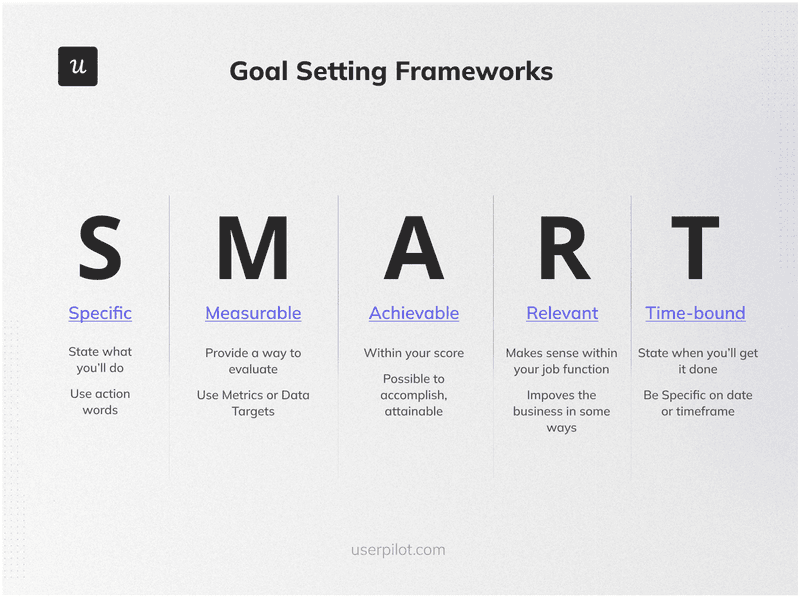
Userpilot – Best digital adoption platform for SaaS
Bias aside, I genuinely believe Userpilot is a powerful no-code digital adoption solution that simplifies and streamlines the digital adoption process for SaaS businesses across web and mobile apps. It helps ensure customers adopt your product and derive maximum value from it.
Create in-app guidance to onboard users
Our array of features helps you improve the user onboarding experience and achieve successful adoption easily. We offer tools like tooltips, interactive walkthroughs, and resource centers to guide users along the user journey.
And it’s not limited to just in-app. You can deliver these experiences across web, mobile, and email for consistent messaging wherever your users are.
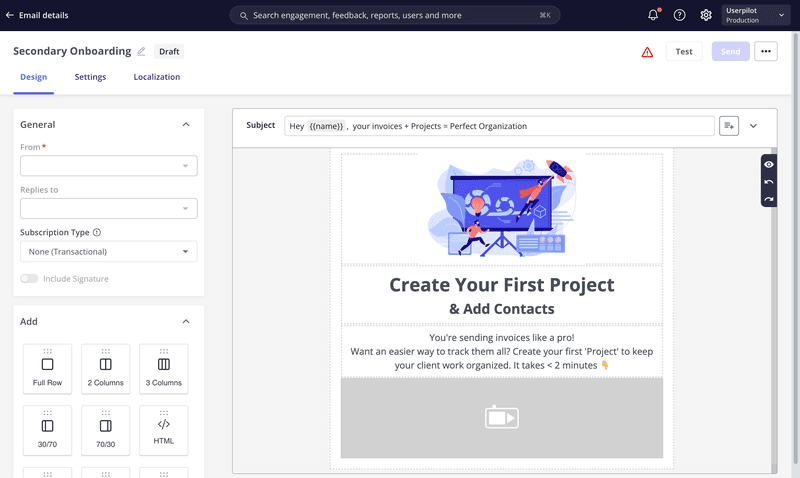
Don’t take my word for it. See how Smoobu used Userpilot to test different onboarding approaches across multiple user segments and saw a 17% increase in conversions.
They targeted new users with onboarding flows, re-engaged drop-offs with contextual messages, and guided power users toward advanced features.
I’d definitely recommend Userpilot. It allows us the flexibility to move fast, experiment, and really understand what users need. It’s helped us speed up processes and create a smoother user experience.
– Dasha Frantz, Product Designer at Smoobu
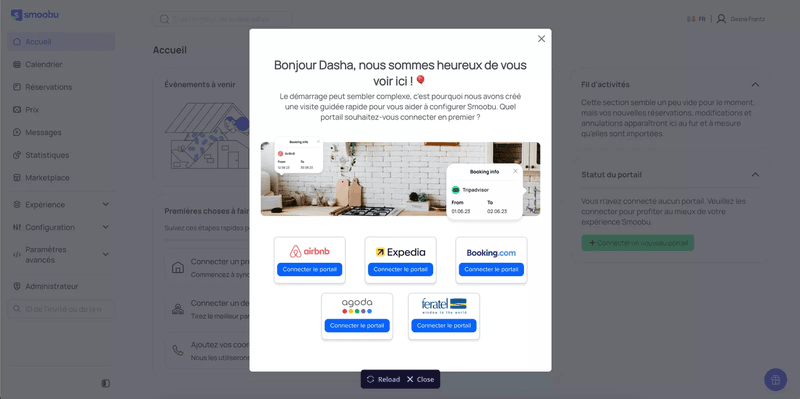
Monitor user adoption progress with robust analytics
Another essential aspect of Userpilot is its robust analytics capabilities. It allows you to monitor and evaluate user adoption progress continually. For instance, your sales team can use adoption analytics to identify expansion opportunities. When users consistently engage with advanced features, that signals readiness to upgrade.
Our key analytics features include:
- Autocapture: You can automatically track every click, page view, and user interaction without manual event tagging. Start analyzing behavior immediately after installation.
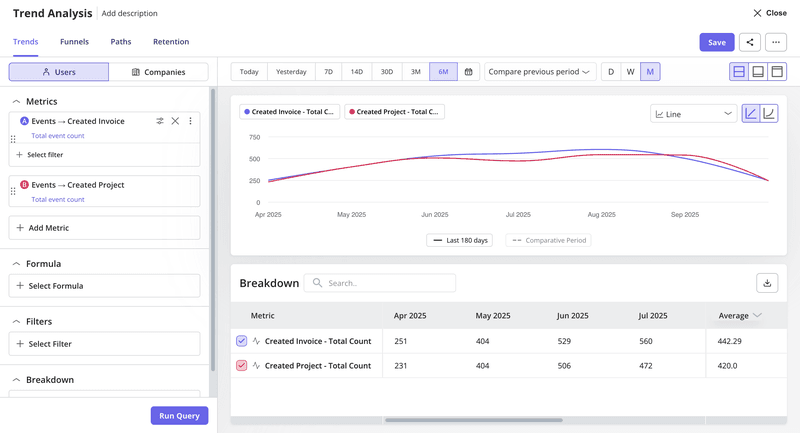
- Session replays: You can watch recordings of actual user sessions to see exactly where users get stuck, confused, or drop off. Spot UX issues that quantitative data alone can’t reveal.
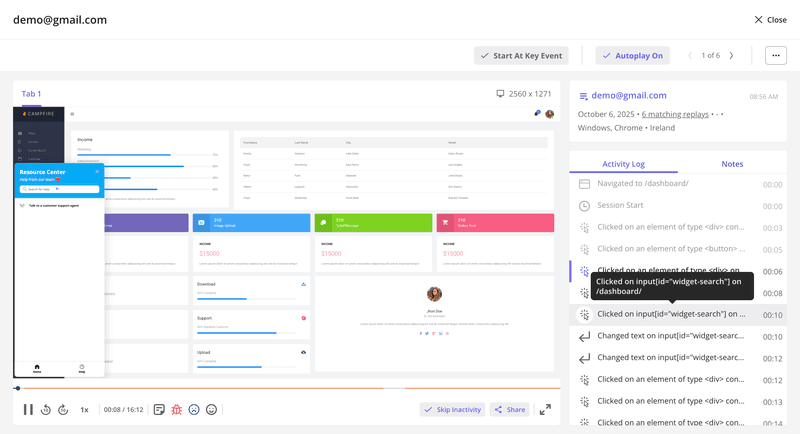
You can quickly gain insights into feature usage, checklist completion, and feedback analytics. All that makes it easier to identify areas for improvement and optimize your digital adoption process.
Gather user feedback and act on it
Userpilot also lets you create and trigger surveys to gather valuable user feedback regarding their experience and satisfaction. It allows you to send microsurveys like NPS, CSAT, CES, and mobile surveys, by creating from scratch or customizing a template.
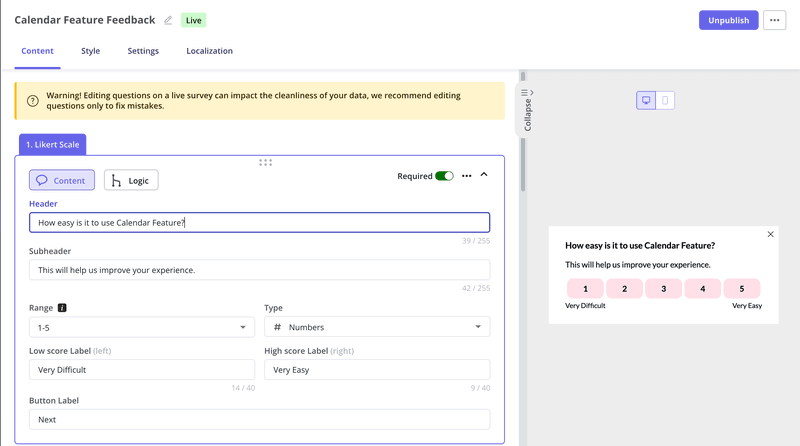
With advanced user segmentation and engagement features, you can ensure the most relevant audience gets the surveys at the right time.

We also built a user-friendly dashboard to monitor survey responses and gain actionable insights for informed decision-making.
Power your digital adoption strategy with Userpilot!
You now have 10 proven digital adoption strategies to maximize engagement and business outcomes. The challenge is implementing them without overwhelming your team or waiting on engineering.
Userpilot lets you execute your complete digital adoption strategy with tools for personalized onboarding, contextual guidance, user feedback, and analytics. Build across web, mobile, and email from one platform without needing an engineer.
Whether you’re onboarding users, driving feature adoption, or re-engaging at-risk accounts, Userpilot lets you build, test, and iterate in minutes instead of weeks.
Book a demo with Userpilot to see the platform in action and start improving activation and retention.
FAQ
What is a digital adoption plan?
A digital adoption plan outlines how to help users learn, use, and get maximum value from new technology. It includes training sessions, support systems, and metrics to track progress.
What are the 4 pillars of digital transformation?
- People: skills, mindset, and leadership
- Process: workflows and automation
- Technology: tools and infrastructure
- Data: insights to drive decisions
What are the 4 types of adopters?
- Innovators: first to try new technology
- Early adopters: quick to embrace new ideas
- Late adopters: cautious and slower to change
- Laggards: resist change as long as possible







